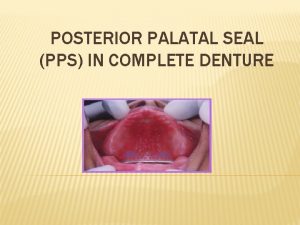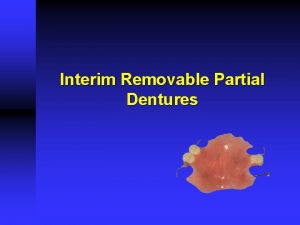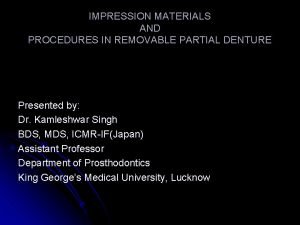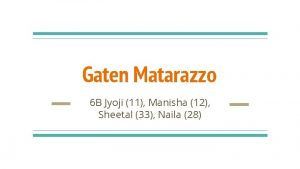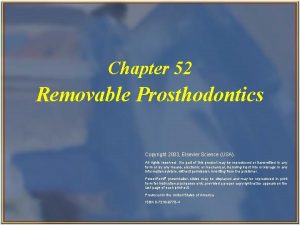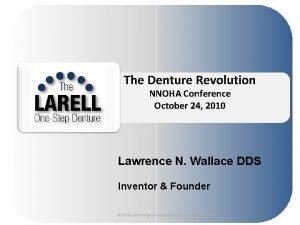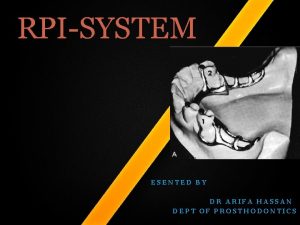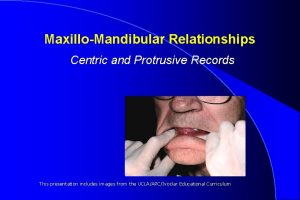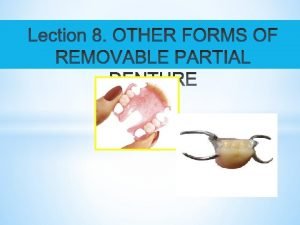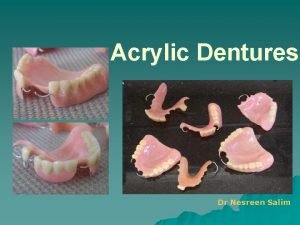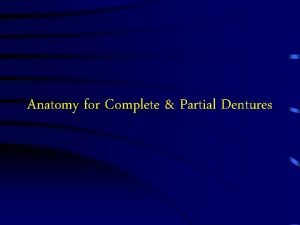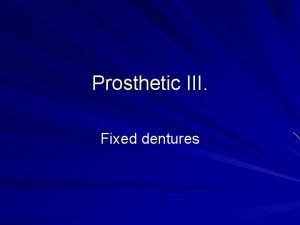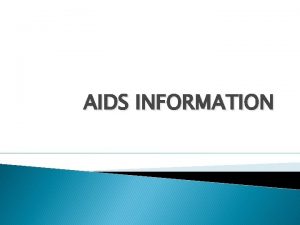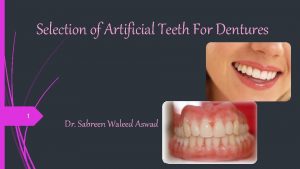LESSON 19 DevicesInterventions ProstheticsHearing Aids Artificial EyeEyeglasses Dentures












- Slides: 12

LESSON 19 Devices/Interventions/ Prosthetics/Hearing Aids/ Artificial Eye/Eyeglasses/ Dentures/ Compression Stockings

Objectives �Student will be able to explain the role of the NA related to caring for and maintaining: Prosthetic Devices: artificial limbs, hearing aids, artificial eyes, eyeglasses, and dentures Elastic Compression Stockings (TED hose) �Student will be able to explain the role of the NA regarding care for a resident with an amputation and prosthetic device

Prosthetic Devices �Amputation- removal of body part, usually as a result of injury or disease �Prosthesis/Prosthetic Device- device to substitute for deformed or missing body part �Phantom Pain/Phantom Sensation- pain in a limb despite amputation as a result of remaining nerve endings

Hearing Aids �Hearing aids- small, battery operated device that fit into the ears to amplify sound RCP #70 Sometimes color indicates which ear Red=Right Blue=Left

Hearing Aid �Clean residents ear with damp washcloth, clean hearing aid per manufacturers instructions �Keep water away from area where batteries are attached �Once ear is dry, place them in ear per instructions �Ask resident if they can hear which would indicate sound is being amplified �Observe for wax build up, if so report to nurse �Store in labeled case when not in use �If residents is not able to hear, check/change batteries �If buzzing/whistling occurs, volume may need adjusted

Eye Prosthesis �Device to resemble the natural eye, but does not allow the person to see �Held in the eye socket by suction and the upper and lower eye lids �Can be removed and inserted by nurse, NA, or resident �Check for cleanliness �Stored in clean container in proper solution (saline or distilled water) otherwise drying and cracking of the device can occur �Report if eye socket is inflamed, reddened or draining �Follow Care Plan as some residents may not remove daily http: //www. ericksonlabs. com/v/Artificial_Eyes/care_handling. asp

Eyeglasses �Should be kept clean �Worn while resident is awake �Clean with warm (not hot) water and a mild soap, dry with cotton cloth or use eye glass solution and cloth �Store in safe place when not in use �Report any damage to the glasses or lens �Report if resident complains of blurred vision, headaches, or not seeing well

Dentures RCP #38 �May consist of partial sets, with some teeth or full set with no teeth �Encourage wearing them, especially for meals �Removed and stored in labeled denture cup filled with cool water at night and kept in a safe place �Be sure to check napkins, meal trays and bed linens before removing them �Brush at least daily, but many prefer more frequently �Handle with care; they are very fragile and expensive and will break if dropped on the floor or in the sink �Be sure to also GENTLY brush/clean residents mouth, tongue, and any remaining teeth

Denture Essentials

Elastic Compression Stockings RCP #71 �TED hose (thromboembolic deterrent stocking)- specialized hosiery designed to help prevent blood clots and swelling by compressing the limb and reducing the diameter of swollen veins so blood doesn’t pool in the lower extremities �To be worn when out of bed and according to the care plan if ordered by the physician �Applied by the NA or nurse �Ensure they are wrinkle free �Wash in sink at bedtime and hang to dry

Amputation & Artificial Limbs �Can often be difficult for resident to accept due to change in body image and functional impairment, therefore, be sensitive to residents feelings �Keep skin under prosthetic clean and dry �Check skin on the stump for signs of pressure and irritation: Redness, Warmth, Swelling, Tenderness, and Skin Breakdown (open areas) �Follow Care Plan regarding care of the prosthesis and applying and removing �Handle with care �If resident refuses to wear, respect the decision, but notify the nurse

Review Questions 1. When providing care, the stump should be observed for what abnormalities? 2. How should a hearing aid be cleaned? 3. What is an important consideration when applying TED stockings?

